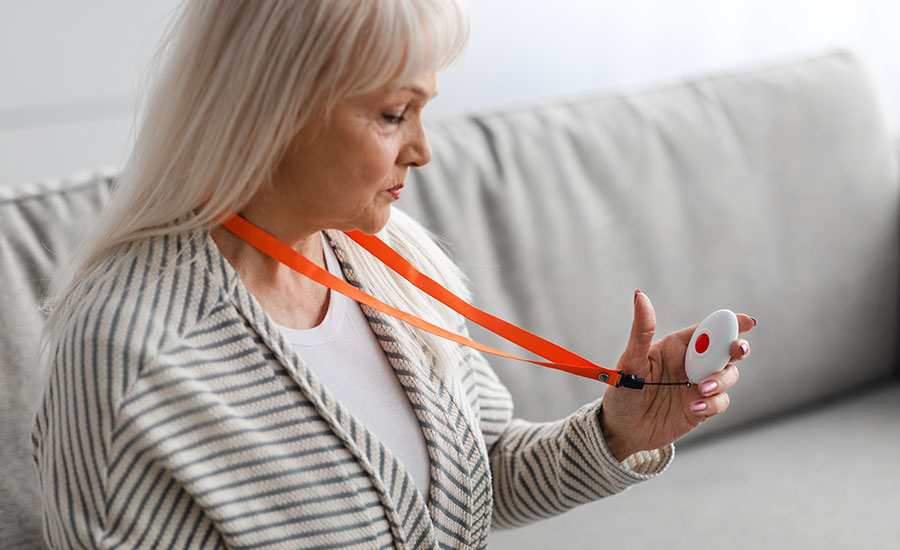A Full Guide To Personal Emergency Response Systems (PERS)

As your loved one ages and becomes more likely to encounter issues with memory, balance, coordination and health deterioration, living alone can pose an increasing risk.
Research shows that around 41% of American adults over the age of 75 may be living alone. If this includes your loved one, you may be concerned about safety and immediate assistance in case of a medical emergency.
This is where a personal emergency response system (PERS) can help.
We’ll explain what a personal emergency response system is, including the different types, how it works and the benefits it offers. Plus, we’ll introduce you to our Personal Emergency Response System at Always Best Care — ready to help your loved ones in need.
Table of Contents
What Is a Personal Emergency Response System (PERS)?
A personal emergency response system is an electronic device that is equipped with two components: a small radio transmitter and a console connected to the telephone.
When an individual is experiencing a medical emergency, the device is activated and alerts an emergency response center.
The representative at the center identifies the caller and the emergency, then calls the individual’s emergency contacts, such as family members or caregivers.
Who Uses a Personal Emergency Response System?
A PERS device can be used by a wide range of individuals who may need immediate assistance in case of an emergency. This can include:
- Elderly individuals: A PERS device is often used by seniors who live alone, who are on fall risk medications or otherwise at risk of a medical emergency. The system allows them to quickly call for help if they can’t reach a phone.
- Individuals with disabilities: Individuals with physical or cognitive disabilities can benefit from a PERS device. For those with mobility issues, reaching for a phone during an emergency could be challenging. On the other hand, individuals with cognitive disorders (such as Alzheimer’s) might find it difficult to dial a number or remember emergency contact numbers.
- Individuals with chronic health conditions: Those with serious health conditions, such as heart disease, severe allergies, epilepsy, or any condition that can cause them to lose consciousness or become incapacitated, can also benefit from a PERS device.
- Recovering patients: Patients who are recuperating from surgery or an illness at home can use a PERS device during their recovery period while they are weak or less mobile.
How Does a PERS Device Work?
Here’s a step-by-step process of how a typical PERS device works:
- The PERS device is worn by the individual: The individual wears the PERS device, which usually comes as a pendant, bracelet, or wristband.
- A signal is transmitted: When the button on the device is pressed, it sends a signal to a console unit located in the person’s home. This console is typically connected to the individual’s telephone line, cellular network, or WiFi.
- A call is made to the response center: The console dials one or more programmed numbers within 30 seconds, usually to an emergency response center that provides a 24/7 monitoring service. An operator at the center receives the call.
- The operator communicates with the individual: Once the connection is made, the individual can communicate with the operator directly through a speaker and microphone in the console unit. If the individual cannot speak or does not respond, the operator will still initiate emergency procedures.
- Immediate medical attention is delivered: If the individual experiences a fall or chronic health condition (such as a heart attack) that needs immediate medical attention, the operator will contact the nearest responder (a friend, family member, caregiver, or neighbor) to notify them of the situation. The operator can also call the nearest health facility, so an ambulance is dispatched to the individual’s home to check on them. Depending on the specific protocols, the designated family member or caregiver will be asked to go directly to the individual’s location, meet the emergency responders, and provide additional information about the individual’s health history or needs.
- The operator stays on the call: Once help is on the way, the operator will stay on the line until help arrives.
5 Types of Personal Emergency Response Systems
There are different types of personal emergency response systems that vary based on the need. The most common types of PERS devices include:
1. Landline Personal Emergency Response System
A landline personal emergency response system is a type of PERS device that is connected to the user’s telephone line.
The user wears a transmitter (typically as a wristband or pendant) then presses the emergency button when they’re in need. The system then dials a programmed number to get in touch with an emergency response center.
2. Cellular Personal Emergency Response System
A cellular personal emergency response system is a type of PERS device that utilizes cellular networks instead of a landline.
This device is useful for those who do not have a traditional phone line in their homes or prefer the flexibility of cellular connectivity.
3. Mobile Personal Emergency Response System
Unlike traditional systems that are designed to work within a certain range of the console, a mobile personal emergency response system is designed to work anywhere, similar to a mobile phone.
This device uses cellular networks to connect to an emergency response center and often includes GPS technology to help locate the user in case of an emergency.
4. GPS-Based Personal Emergency Response System
A GPS-based personal emergency response system is a type of PERS device that utilizes global positioning system technology to identify the user’s location during an emergency.
This device is useful for those who might experience an emergency outside of their home, such as a senior citizen with dementia who might wander off or active seniors who travel or spend a lot of time outdoors.
5. Mobile Applications With Emergency Alerts
Mobile applications with emergency alerts are software applications that can be installed on smartphones or other mobile devices.
This device offers features similar to other PERS devices, such as one-touch emergency call buttons, GPS location tracking, and even fall detection.

Key Benefits of a Personal Emergency Response System
A PERS device offers peace of mind for both you and your loved one, knowing that help is just a button away.
The benefits of a personal emergency response system for your loved one include:
- Immediate assistance: With the push of a button, your loved one can ask for help within seconds, which is critical in emergencies, such as falls, heart attacks, or strokes, where every minute counts.
- Around-the-clock monitoring: Emergency response centers offer 24/7 monitoring services, so your loved one can get help whenever they need it.
- Independence: PERS devices can help your loved one live independently and improve their overall quality of life, knowing that help is available when they need it.
- Mobility: PERS devices, such as mobile and GPS-enabled systems, can provide protection anywhere — even outside your loved one’s home. This can be particularly beneficial for active seniors who still drive or travel.
- Ease of use: PERS devices are designed to be user-friendly (with easy-to-press buttons), which is particularly important in stressful emergency situations.
- Additional features: Some PERS devices come with extra features like fall detection, medication reminders, or wellness checks, further improving your loved one’s safety and well-being.
The benefits that a personal emergency response system can offer you as a caregiver include:
- Peace of mind: As the primary caregiver, knowing that your loved one is equipped with a PERS device can provide you with the peace of mind you need if a medical emergency occurs.
- Immediate medical attention: If a medical emergency occurs, immediate response can prevent a situation from escalating.
Factors To Consider When Looking for a PERS Device
When looking for a PERS device, there are several factors you should consider to make sure it meets your loved one’s specific needs.
These factors include:
- Type of device: Does your loved one spend most of their time at home, or do they also travel? Choose your loved one’s PERS device depending on their lifestyle and needs.
- Range of the device: When choosing a landline-based system, check the device’s range from the console to make sure it can cover the entire house, yard, and outdoor surroundings. When choosing a cellular-based system, determine whether the device’s connectivity can reach areas where your loved one spends most of their time, like their favorite park, local grocery store, or community center. Make sure that the cellular signal is strong and consistent both inside and outside the home to ensure constant protection.
- Battery life: Check the battery life of the device, as well as what happens when the battery is low. Most PERS devices will beep or send a notification when it’s time to charge, while other devices are equipped with a back-up battery so they can still work for a short period of time without a charge.
- Water resistance: For accidents that might happen in the bathroom or shower, make sure the PERS device is water-resistant or waterproof, so your loved one can wear it or keep it nearby when they bathe.
- Fall detection: Some PERS devices are equipped with automatic fall detection, which can call for help if a fall is detected and your loved one can’t press the button.
- Additional features: Some devices offer additional features such as medication reminders or health monitoring.

Explore Our Personal Emergency Response System at Always Best Care Senior Services
Operating in over 200 locations, our caring and reliable team at Always Best Care Senior Services is dedicated to offering consistent support tailored to your loved one’s needs.
We create a unique care plan for each client, which includes personal emergency response systems, to ensure your loved one’s safety and well-being, regardless of where they are.
The Always Best Care PERS device is an intuitive emergency system designed to provide swift help to the elderly, in the event of a medical emergency.
We teamed up with Total Remote Health and ADT to offer mobile medical alerts with GPS and home-based cellular alerts, ensuring immediate assistance whenever it’s needed.
We offer two solutions for emergency response:
- In-home solution: Medical Alert Plus is a home-based system that uses cellular connection. It offers a 600-foot range for mobility within the home and includes features such as temperature monitoring to ensure a safe environment.
- Mobile solution: On-The-Go Emergency Response is a lightweight, portable system that’s ideal for active individuals. With its GPS capabilities, it can locate your loved one no matter where they are, at any time of the day or night.
At Always Best Care, our services include:
- Respite care: We provide temporary, comprehensive care, allowing you to take the time off to rest, attend to other family members, or run errands.
- In-home care services: We provide everything from around-the-clock care and meal preparation to companionship and beyond, all in the comfort of your loved one’s home.
- Skilled home health care: At some select Always Best Care locations, we offer tailored care plans for specific needs, including personal care services and chronic disease management.
- Specialized home care: We utilize advanced techniques and innovative technology, like remote patient monitoring and digital balance assessments, to carefully monitor your loved one’s health.
- Senior living referral services: We guide you in making informed choices about assisted living communities that offer 24/7 emergency care, medical services, personal care, housekeeping, and social activities.
- Veterans assistance program: We ensure your veteran loved one receives top-quality care by helping them secure financial resources, while ensuring that they receive the respect and attention they deserve.
At Always Best Care Senior Services, we understand the importance of your loved ones’ well-being. That’s why we’re here for you every step of the way, providing compassionate support and guidance.
Our team of dedicated professionals deliver only the highest quality of care, giving you peace of mind knowing that your loved one is in the hands of caregivers who will treat them with the utmost compassion and respect.





